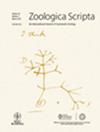墨西哥过渡带墨西哥高原仙人掌蜣螂的适应性转变
IF 2
2区 生物学
Q2 EVOLUTIONARY BIOLOGY
引用次数: 0
摘要
墨西哥过渡带是一个生物地理环境复杂的地区,在这里,具有新热带和近地亲缘关系的新老类群相互重叠。该地区的生物群是由 "仙龙"(cenocrons)的连续扩散事件组合而成的。"仙龙 "是在特定时间间隔内从北美和南美扩散到该地区,然后在该地区分化的一组类群。墨西哥高原岑诺克隆与新热带地区有亲缘关系,分布在近北极地区的温带和干旱气候中。我们假设它经历了环境生态位的适应性转变。我们利用系统发育比较框架、测量系统发育信号和拟合单最优宏观进化模型以及具有多最优的奥恩斯坦-乌伦贝克宏观进化模型对这一假设进行了检验。我们利用Phanaeini科的系统发育和分布信息来评估墨西哥过渡区(MTZ)内最早(墨西哥高原)和最近(典型的新热带地区)的仙人掌科之间是否存在保守性差异,因为该科是起源于新热带地区的仙人掌科扩散和多样化模式的典型例子。我们发现了环境要求的不同变化,这些变化与墨西哥高原岑龙的生态位描述相吻合,表明它是通过在墨西哥过渡区的多次适应性变化而建立起来的。本文章由计算机程序翻译,如有差异,请以英文原文为准。
Adaptive shifts in Phanaeini dung beetles of the Mexican plateau cenocron in the Mexican transition zone
The Mexican Transition Zone is a biogeographically complex area where old and new lineages of Neotropical and Nearctic affinities overlap. Its biota was assembled by successive dispersal events of cenocrons, which are sets of taxa that dispersed during a given time interval from both North and South America and then diversified in the area. The Mexican Plateau cenocron, with Neotropical affinities, is found in temperate and dry climates in the Nearctic region. We hypothesised that it underwent an adaptive shift in environmental niche. We tested this hypothesis using a phylogenetic comparative framework, measuring phylogenetic signal and fitting to single optima macroevolutionary models, and an Ornstein‐Uhlenbeck macroevolutionary model with multiple optima. We used phylogenetic and distributional information of the tribe Phanaeini to assess whether there exists a distinction in conservatism between the earliest (Mexican Plateau) and most recent (Typical Neotropical) cenocrons within the Mexican Transition Zone (MTZ) as this tribe stands as a classic example of the dispersal and diversification patterns of cenocrons originating in the Neotropics. We identified different shifts in environmental requirements that match the niche description of the Mexican Plateau cenocron, suggesting that it was established through multiple adaptive shifts in the Mexican Transition Zone.
求助全文
通过发布文献求助,成功后即可免费获取论文全文。
去求助
来源期刊

Zoologica Scripta
生物-动物学
CiteScore
5.60
自引率
0.00%
发文量
52
审稿时长
>12 weeks
期刊介绍:
Zoologica Scripta publishes papers in animal systematics and phylogeny, i.e. studies of evolutionary relationships among taxa, and the origin and evolution of biological diversity. Papers can also deal with ecological interactions and geographic distributions (phylogeography) if the results are placed in a wider phylogenetic/systematic/evolutionary context. Zoologica Scripta encourages papers on the development of methods for all aspects of phylogenetic inference and biological nomenclature/classification.
Articles published in Zoologica Scripta must be original and present either theoretical or empirical studies of interest to a broad audience in systematics and phylogeny. Purely taxonomic papers, like species descriptions without being placed in a wider systematic/phylogenetic context, will not be considered.
 求助内容:
求助内容: 应助结果提醒方式:
应助结果提醒方式:


